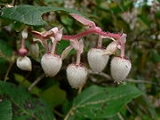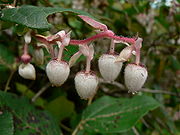
Drift Creek Wilderness
Encyclopedia
Drift Creek Wilderness is a 5798 acres (2,346.4 ha) wilderness area in the Siuslaw National Forest
on the Oregon Coast
. It was created in 1984, along with two other small wilderness areas in the Forest - Cummins Creek Wilderness
and Rock Creek Wilderness
. The elevation of Drift Creek ranges from 150 to 1500 ft (45.7 to 457.2 ), and is characterized by long steep slopes with broken and uneven terrain. Drift Creek was named for the accumulations of driftwood on its banks.
the Wilderness. Fred Purath operated a subsistence farm and ran a few head of cattle. When he died in the early 1940s his land was purchased by Earl Harris. The only relic of the so-called Harris Ranch homestead is a moss-covered stove and stove parts along the Harris Ranch Trail.
 Drift Creek Wilderness generally receives some 120 inches (3,048 mm) of rain per year, which leads to a very lush environment. It contains one of the largest remaining stands of old growth in the Coast Range. Sitka spruce
Drift Creek Wilderness generally receives some 120 inches (3,048 mm) of rain per year, which leads to a very lush environment. It contains one of the largest remaining stands of old growth in the Coast Range. Sitka spruce
, western hemlock
, western red cedar, and Douglas fir dominate the area, but bigleaf maple
and red alder
can be found as well. Much of the underbrush is licorice fern
, sourgrass
, oxalis
, salmonberry
, thimbleberry
, huckleberry
, foxglove, trillium
, sword fern, and salal
.
, black-tailed deer
, and black bear
share Drift Creek Wilderness with two endangered Oregon species - the northern spotted owl
and the bald eagle
. In autumn, chinook
and coho salmon
, as well as steelhead and cutthroat trout
use Drift Creek, a tributary of the Alsea River
, to spawn.
Siuslaw National Forest
Siuslaw National Forest is a national forest in western Oregon, United States. Established in 1908, the Siuslaw is made up of a wide variety of ecosystems, ranging from coastal forests to sand dunes.- Geography :...
on the Oregon Coast
Oregon Coast
The Oregon Coast is a region of the U.S. state of Oregon. It runs generally north-south along the Pacific Ocean, forming the western border of the state; the region is bounded to the east by the Oregon Coast Range. The Oregon Coast stretches approximately from the Columbia River in the north to...
. It was created in 1984, along with two other small wilderness areas in the Forest - Cummins Creek Wilderness
Cummins Creek Wilderness
The Cummins Creek Wilderness is a wilderness area in the Siuslaw National Forest on the Oregon coast. It is one of three wilderness areas created in the Siuslaw in 1984, along with Drift Creek and Rock Creek...
and Rock Creek Wilderness
Rock Creek Wilderness
The Rock Creek Wilderness is a wilderness area comprising within the Siuslaw National Forest on the Oregon Coast. It was created in 1984, along with the Drift Creek Wilderness and Cummins Creek Wilderness.-Topography:...
. The elevation of Drift Creek ranges from 150 to 1500 ft (45.7 to 457.2 ), and is characterized by long steep slopes with broken and uneven terrain. Drift Creek was named for the accumulations of driftwood on its banks.
Human history
Natives of the Alsea tribe used to hunt and gather berries in Drift Creek Wilderness and the surrounding area. Later, in the early 20th century, American settlers tried unsuccessfully to homesteadHomestead (buildings)
A homestead is either a single building, or collection of buildings grouped together on a large agricultural holding, such as a ranch, station or a large agricultural operation of some other designation.-See also:* Farm house* Homestead Act...
the Wilderness. Fred Purath operated a subsistence farm and ran a few head of cattle. When he died in the early 1940s his land was purchased by Earl Harris. The only relic of the so-called Harris Ranch homestead is a moss-covered stove and stove parts along the Harris Ranch Trail.
Vegetation

Sitka Spruce
Picea sitchensis, the Sitka Spruce, is a large coniferous evergreen tree growing to 50–70 m tall, exceptionally to 95 m tall, and with a trunk diameter of up to 5 m, exceptionally to 6–7 m diameter...
, western hemlock
Western Hemlock
Tsuga heterophylla. the Western Hemlock, is a species of hemlock native to the west coast of North America, with its northwestern limit on the Kenai Peninsula, Alaska, and its southeastern limit in northern Sonoma County, California.-Habitat:...
, western red cedar, and Douglas fir dominate the area, but bigleaf maple
Bigleaf Maple
Acer macrophyllum is a large deciduous tree in the genus Acer.It can grow to be up to 35 m tall, but more commonly grows 15 m to 20 m tall. It is native to western North America, mostly near the Pacific coast, from southernmost Alaska to southern California...
and red alder
Red Alder
Alnus rubra, the Red alder, is a deciduous broadleaf tree native to western North America.-Description:It is the largest species of alder in North America and one of the largest in the world, reaching heights of 20–35 m. The official tallest red alder stands 32 meters tall in Clatsop County, Oregon...
can be found as well. Much of the underbrush is licorice fern
Licorice fern
Polypodium glycyrrhiza, commonly known as licorice fern, many-footed fern, and sweet root, is an evergreen fern native to western North America, primarily in a narrow strip in southern Alaska, southwestern Yukon Territory, western British Columbia, Washington, Oregon, and California, though two...
, sourgrass
Sourgrass
Sourgrass is a common name given to several plant species which have a sour taste. Most are in fact not grasses:* Digitaria insularis, a true grass * Oxalis species of the Oxalidaceae, namely:...
, oxalis
Oxalis
Oxalis is by far the largest genus in the wood-sorrel family Oxalidaceae: of the approximately 900 known species in the Oxalidaceae, 800 belong here...
, salmonberry
Salmonberry
Rubus spectabilis is a species of Rubus native to the west coast of North America from west central Alaska to California....
, thimbleberry
Thimbleberry
Rubus parviflorus, commonly called thimbleberry or salmonberry, is a species of Rubus, native to western and northern North America, from Alaska east to Ontario and Michigan, and south to northern Mexico...
, huckleberry
Huckleberry
Huckleberry is a common name used in North America for several species of plants in two closely related genera in the family Ericaceae:* Vaccinium* GaylussaciaHuckleberry may also refer to:-Plants:...
, foxglove, trillium
Trillium
Trillium is a genus of about 40–50 species of spring ephemeral perennials, native to temperate regions of North America and Asia....
, sword fern, and salal
Salal
Gaultheria shallon is a leathery-leaved shrub in the heather family , native to western North America. In English it is known as salal, shallon, or in Britain simply Gaultheria.-Ecology:...
.
Wildlife
Roosevelt elkRoosevelt elk
The Roosevelt elk , also known as Olympic elk, is the largest of the four surviving subspecies of elk in North America...
, black-tailed deer
Black-tailed Deer
Two forms of black-tailed deer or blacktail deer occupying coastal temperate rainforest on North America's Pacific coast are subspecies of the mule deer. They have sometimes been treated as a species, but virtually all recent authorities maintain they are subspecies...
, and black bear
American black bear
The American black bear is a medium-sized bear native to North America. It is the continent's smallest and most common bear species. Black bears are omnivores, with their diets varying greatly depending on season and location. They typically live in largely forested areas, but do leave forests in...
share Drift Creek Wilderness with two endangered Oregon species - the northern spotted owl
Spotted Owl
The Spotted Owl, Strix occidentalis, is a species of true owl. It is a resident species of forests in western North America, where it nests in tree holes, old bird of prey nests, or rock crevices. Nests can be between 13 and 66 yards high and usually contain two eggs...
and the bald eagle
Bald Eagle
The Bald Eagle is a bird of prey found in North America. It is the national bird and symbol of the United States of America. This sea eagle has two known sub-species and forms a species pair with the White-tailed Eagle...
. In autumn, chinook
Chinook salmon
The Chinook salmon, Oncorhynchus tshawytscha, is the largest species in the pacific salmon family. Other commonly used names for the species include King salmon, Quinnat salmon, Spring salmon and Tyee salmon...
and coho salmon
Coho salmon
The Coho salmon, Oncorhynchus kisutch, is a species of anadromous fish in the salmon family. Coho salmon are also known as silver salmon or "silvers". It is the state animal of Chiba, Japan.-Description:...
, as well as steelhead and cutthroat trout
Cutthroat trout
The cutthroat trout is a species of freshwater fish in the salmon family of order Salmoniformes. It is one of the many fish species colloquially known as trout...
use Drift Creek, a tributary of the Alsea River
Alsea River
The Alsea River flows from Alsea, an unincorporated community in the coastal mountains of the U.S. state of Oregon, to the Pacific Ocean near the city of Waldport. It begins at the confluence of the North Fork Alsea River and the South Fork Alsea River and ends in Alsea Bay, a wide estuary at...
, to spawn.
Recreation
Primary recreational activities in Drift Creek Wilderness include hiking, hunting, fishing, and wildlife watching. Fishing is managed for native fish only. There are approximately 8.5 miles (14 km) of trail in the wilderness area. Horseback riding is prohibited due to the fragility of the soil.See also
- List of Oregon Wildernesses
- List of U.S. Wilderness Areas
- List of old growth forests
- Wilderness ActWilderness ActThe Wilderness Act of 1964 was written by Howard Zahniser of The Wilderness Society. It created the legal definition of wilderness in the United States, and protected some 9 million acres of federal land. The result of a long effort to protect federal wilderness, the Wilderness Act was signed...

